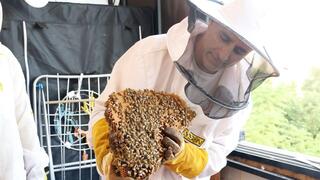
Over 20,000 bees have chosen the Ben Attar family's home in northern Tel Aviv as their new permanent residence. The original residents, after being stung multiple times noticed that the bees were flying back and forth from the same spot on the balcony. The family contacted the municipality to handle the nuisance, but rather than exterminating the bees, the municipality sent the Magen Dvorim Adom organization.
The NGO is dedicated to rescuing bee swarms that have settled in places where they cause disturbances. "Every year, a new queen emerges during the spring and summer months, forming a new swarm that sets out to find its home," explained Yuval Shav, the Tel Aviv Municipality’s animal community and biodiversity coordinator. "In nature, the swarm establishes its hive in tree trunks or caves, but in urban areas, the optimal conditions are often found in wall cracks or air-conditioning ducts,” he added.

5 View gallery ( Photo: Dana Kopel ) In urban areas, bees face threats from pesticides and other hazards, which can disrupt the local ecological balance. To prevent this, the municipality decided to support a unique community of bee enthusiasts in Tel Aviv-Jaffa and launched an initiative to set up bee migration boxes. “The municipality purchased dozens of migration boxes, which are placed in community gardens, balconies, building rooftops and urban green spaces during swarm season,” Shav said.
“Volunteers maintain the boxes, coat the entrance with beeswax to attract the swarm, monitor its well-being and eventually transfer it from the box to a permanent hive.” 5 View gallery ( Photo: Dana Kopel ) Setting up migration boxes for bees is a common practice in many cities worldwide, but Tel Aviv is the first city where the project is fully managed and led by local amateur beekeepers. To aid the Ben Attar family, Tzur Genosar, a volunteer with Magen Dvorim Adom, an amateur beekeeper and second-generation beekeeper, arrived on the scene.
"First of all, if you see bees, don’t wave your hands," he warned. 5 View gallery ( Photo: Dana Kopel ) "We'll start by dismantling the colony mass, transferring it to a temporary hive, setting aside the honey and moving the entire complex to agricultural hives in the north that were impacted by the war in Gaza,” he explained. After sawing through the panel where the bees had nested and exposing the hive, Genosar used smoke from burning eucalyptus leaves to distract and calm them.
"I'd work without protective gear if they weren't agitated," he said, putting on gloves only after being stung on his finger. 5 View gallery ( Photo: Dana Kopel ) This isn't his first bee swarm rescue; a few months ago, Genosar was called to another neighborhood to remove a hive that had formed two meters high in an abandoned storage space. In the Ben Attar family's case, it was a standard hive containing about 23,000 bees and a queen.
"We need to find the queen inside all of them. If we don’t ensure the queen is moved, the hive has no future. Without a queen laying eggs, the whole colony dies within two months.
" He searched for the queen in each honeycomb piece extracted from the hive and after a few hours, successfully located and rescued the swarm. In the coming days, the swarm will make its way from a temporary hive to a permanent location in the north, either in Metula or Lehavot HaBashan. Get the Ynetnews app on your smartphone: Google Play : https://bit.
ly/4eJ37pE Apple App Store : https://bit.ly/3ZL7iNv >.














